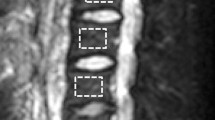Abstract
The effective transverse relaxation time T2* is influenced by the presence of trabecular bone, and can potentially provide a measure of bone density as well as bone structure. We determined the in vivo precision of T2* in repeated bone marrow measurements. The T2* measurements of the bone marrow of the distal radius were performed twice within 2 weeks in six healthy young volunteers using a modified water-presaturated 3D Gradient-Recalled Acquisition at Steady State (GRASS) sequence with TE 7, 10, 12, 20, and 30; TR 67; flip angle (FA) 90 °. An axial volume covering a length of 5.6 cm in the distal radius was measured. Regions of interest (ROIs) were determined manually and consisted of the entire trabecular bone cross-section extending proximally from the radial subchondral endplate. Reproducibility of T2* and area measurements was expressed as the absolute precision error (standard deviation [SD] in ms or mm2) or as the relative precision error (SD/mean × 100, or coefficient of variation [CV] in %) between the two-point measurements. Short-term precision of T2* and area measurements varied depending on section thickness and location of the ROI in the distal radius. Absolute precision errors for T2* times were between 1.3 and 2.9 ms (relative precision errors 3.8–9.5 %) and for area measurements between 20 and 55 mm2 (relative precision errors 5.1–16.4 %). This MR technique for quantitative assessment of trabecular bone density showed reasonable reproducibility in vivo and is a promising future tool for the assessment of osteoporosis.
Similar content being viewed by others
References
Black D, Cummings SR, Melton LJ (1992) Appendicular bone mineral and woman's lifetime risk of hip fracture. J Bone Min Res 7: 639–646
Davis CA, Genant HK, Dunham JS (1986) The effects of bone on proton NMR relaxation times of surrounding liquids. Invest Radiol 21: 472–477
Engelke K, Majumdar S, Genant H (1993) Impact of trabecular structure on marrow relaxation time T2*. Calcif Tissue Int 52: 174
Ford JC, Wehrli FW (1991) In vivo quantitative characterization of trabecular bone by NMR interferometry and localized proton spectroscopy. Magn Reson Med 17: 543–551
Ford JC, Wehrli FW, Chung H (1992) Magnetic field distribution in models of trabecular bone. SMRM 1992. 1: 1302
Gärdsell P, Johnell O, Nilsson BE, Gullberg B (1993) Predicting various fragility fractures in women by forearm bone densitometry: a follow-up study. Calcif Tissue Int 52: 348–353
Grampp S, Jergas M, Glüer CC, Lang P, Brastow P, Genant HK (1993) Radiological diagnosis of osteoporosis: current methods and perspectives. Radiol Clin North Am 31: 1133–1145
Grampp S, Majumdar S, Jergas M, Lang P, Genant HK (1993) In vivo estimation of bone mineral density in the radius using magnetic resonance and peripheral quantitative computed tomography. Radiology 189 (P): 283
Kalender WA, Klotz E, Süss C (1987) Vertebral bone mineral analysis: an integrated approach. Radiology 164: 419–423
Louis O, Luypaert R, Kalender W, Osteaux M (1988) Reproducibility of CT bone densitometry: operator versus automated ROI definition. Eur J Radiol 8: 82–84
Majumdar S (1991) Quantitative study of the susceptibility differences between trabecular bone and bone marrow: computer simulations. Magn Reson Med 22: 101–110
Majumdar S, Genant HK (1992) In vivo relationship between marrow T2* and trabecular bone density determined with a chemical shift-selective asymmetric spin-echo sequence. J Magn Reson Imaging 2: 209–219
Majumdar S, Thomasson D, Shimakawa A, Genant HK (1990) Appearance of bone marrow in the presence of trabecular bone: quantitation of the susceptibility effects and correlation with bone density. Radiology 177 (P): 128–129
Majumdar S, Thomasson D, Shimakawa A, Genant K (1991) Quantitation of the susceptibility difference between trabecular bone and bone marrow: experimental studies. Magn Reson Med 22: 111–127
Mosekilde L, Bentzen SM, Ørtoft G, Jørgensen J (1989) The predictive value of quantitative computed tomography for vertebral body compressive strength and ash density. Bone 10: 465–470
Parfitt AM (1987) Trabecular bone architecture in the pathogenesis and prevention of fracture. Am J Med 82 (Suppl 1 b): 68–72
Rosenthal H, Thulborn KR, Rosenthal DI, Rosen BR (1990) Magnetic susceptibility effects of trabecular bone on magnetic resonance bone marrow imaging. Invest Radiol 25: 173–178
Rüegsegger P, Durand EP, Dambacher MA (1991) Differential effects of aging and disease on trabecular and compact bone density of the radius. Bone 12: 99–105
Sebag GH, Moore SG (1990) Effect of trabecular bone on the appearance of marrow in gradient-echo imaging of the appendicular skeleton. Radiology 174: 855–859
Steiger P, Block JE, Steiger S, Heuck A, Friedlander A, Ettinger B, Harris ST, Glüer CC, Genant HK (1990) Spinal bone mineral density by quantitative computed tomography: effect of region of interest, vertebral level, and technique. Radiology 175: 537–543
Uitewaal PJM, Lips P, Netelenbos JC (1987) An analysis of bone structure in patients with hip fracture. Bone and Mineral 3: 63–67
Wehrli FW, Ford JC, Kaut-Watson C (1990) Quantitative MR: a new method for in vivo characterization of trabecular bone structure. Radiology 177 (P): 245
Author information
Authors and Affiliations
Additional information
Correspondence to: S. Grampp
Rights and permissions
About this article
Cite this article
Grampp, S., Majumdar, S., Jergas, M. et al. MRI of bone marrow in the distal radius: in vivo precision of effective transverse relaxation times. Eur. Radiol. 5, 43–48 (1995). https://doi.org/10.1007/BF00178080
Received:
Revised:
Accepted:
Issue Date:
DOI: https://doi.org/10.1007/BF00178080




